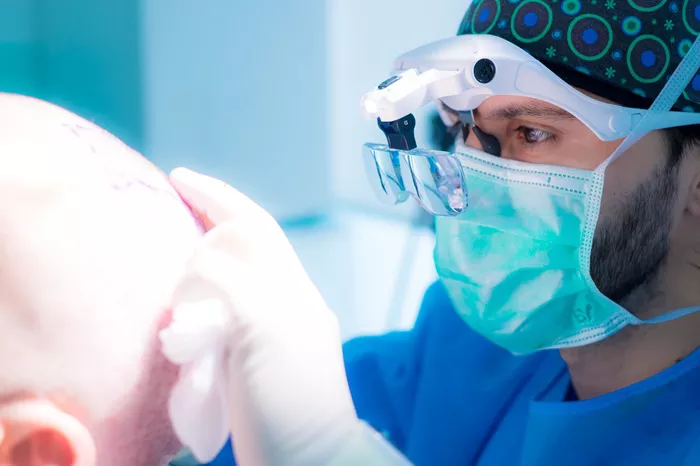Hair transplant procedures offer solutions for individuals experiencing hair loss. There are several types of hair transplant techniques, each with its own advantages and considerations. This comprehensive guide explores the various methods of hair transplantation available today.
1. Follicular Unit Transplant (FUT)
Overview
Follicular Unit Transplant, commonly known as FUT or strip harvesting, involves removing a strip of scalp from the donor area to harvest hair follicles.
Procedure
Strip Harvesting: A strip of scalp containing hair follicles is surgically removed from the donor area, typically the back or sides of the scalp.
Follicle Extraction: The strip is dissected under a microscope to separate individual follicular units containing 1-4 hairs.
Recipient Site Preparation: Tiny incisions are made in the recipient area where the follicular units will be implanted.
Transplantation: Follicular units are carefully implanted into the recipient sites, ensuring natural hair growth patterns.
SEE ALSO: Is It Painful to Get a Hair Transplant?
Advantages
High Yield: Allows for the transplantation of a large number of grafts in a single session.
Less Trauma to Follicles: Hair follicles are less susceptible to damage during the extraction process.
Cost-Effective: Typically more cost-effective compared to some other methods due to efficiency.
Considerations
Linear Scar: Leaves a linear scar at the donor site, which may be visible if hair is worn short.
Recovery Time: Longer recovery time compared to some other methods due to the nature of strip harvesting.
2. Follicular Unit Extraction (FUE)
Overview
Follicular Unit Extraction, or FUE, involves harvesting individual follicular units directly from the scalp.
Procedure
Punch Extraction: Hair follicles are extracted using small, circular punches (usually 0.8mm to 1.0mm in diameter) from the donor area.
Recipient Site Preparation: Similar to FUT, tiny incisions are made in the recipient area.
Transplantation: Individual follicular units are implanted into the recipient sites using specialized tools.
Advantages
No Linear Scar: Leaves tiny, dot-like scars that are less noticeable, making it suitable for those who wear their hair short.
Quicker Recovery: Generally has a faster healing time compared to FUT.
Versatility: Can be used in patients with tighter scalps or who have already undergone FUT.
Considerations
Higher Cost: Typically more expensive per graft compared to FUT due to the labor-intensive nature of extraction.
Lower Graft Yield: May yield fewer grafts per session compared to FUT, especially in larger procedures.
3. Direct Hair Implantation (DHI)
Overview
Direct Hair Implantation, or DHI, is a variation of the FUE technique with additional advancements in hair transplantation.
Procedure
Choi Implanter Pen: Utilizes a Choi Implanter Pen, a specialized tool that creates recipient sites and implants grafts simultaneously.
No Need for Incisions: Allows for direct implantation of hair follicles without the need for prior incisions in the recipient area.
Controlled Depth and Angle: Ensures precise placement of grafts to mimic natural hair growth patterns.
Advantages
Minimized Handling of Grafts: Reduces the time grafts are outside the body, potentially improving graft survival rates.
Enhanced Precision: Allows for more accurate placement of grafts, enhancing aesthetic outcomes.
Faster Healing: Typically results in quicker recovery times compared to traditional FUE.
Considerations
Specialized Training: Requires specialized training for practitioners due to the use of the Choi Implanter Pen.
Cost: Can be more expensive compared to standard FUE due to advanced technology and techniques involved.
4. Robotic Hair Transplantation
Overview
Robotic Hair Transplantation utilizes robotic systems to assist in the harvesting and transplantation of hair follicles.
Procedure
Artificial Intelligence (AI) Planning: AI algorithms analyze the scalp and determine optimal graft harvesting locations.
Robot-Assisted Extraction: Robotic systems harvest follicular units using precise punches, minimizing human error.
Automated Implantation: Implants grafts into recipient sites with high precision, enhancing natural results.
Advantages
Precision and Consistency: Robots can achieve precise graft harvesting and placement, reducing human variability.
Less Invasive: Minimally invasive approach can lead to quicker recovery times and less post-operative discomfort.
Large Sessions: Capable of performing large sessions efficiently, depending on the robotic system’s capabilities.
Considerations
Costly: Generally, robotic procedures are among the most expensive due to the advanced technology involved.
Learning Curve: Requires specialized training and expertise to operate the robotic system effectively.
Availability: Limited availability compared to traditional FUT and FUE procedures, depending on geographic location.
Choosing the Right Method
When considering a hair transplant, several factors should be taken into account:
Hair Loss Pattern: The extent and pattern of hair loss play a crucial role in determining the most suitable technique.
Scalp Characteristics: Scalp laxity and donor hair density influence the feasibility of different methods.
Aesthetic Goals: Desired hair density, naturalness of results, and expectations regarding scarring should be discussed with a qualified surgeon.
Budget and Time: Consider the financial investment and time commitment required for each procedure.
Conclusion
Choosing the right type of hair transplant involves understanding the nuances of each technique and aligning them with individual needs and preferences. Whether opting for FUT, FUE, DHI, or robotic hair transplantation, consulting with a qualified hair restoration specialist is crucial. By considering factors such as hair loss severity, scalp characteristics, and desired outcomes, individuals can make informed decisions to achieve natural-looking, long-lasting results in hair restoration.
You May Be Interested In

